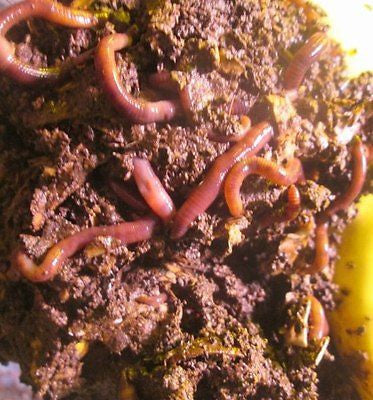Red wigglers: Improve waste management
Red Wigglers: The Secret to Eco-Friendly Composting
Red wigglers, clinically called Eisenia fetida, play an essential function in lasting composting techniques, using a natural remedy to waste management. These worms not just take in natural products but likewise change them right into useful vermicompost, enhancing soil wellness and promoting eco-friendly equilibrium. As metropolitan areas deal with increasing waste challenges, understanding the benefits and correct care of these organisms comes to be vital for both garden enthusiasts and environmentalists alike. What specific steps can people take to harness their prospective properly?
What Are Red Wigglers?
Although lots of people know with earthworms, red wigglers (Eisenia fetida) are a certain species that play an essential role in composting. Native to Europe, they have adjusted well to a range of atmospheres, specifically in disintegrating raw material. Unlike common yard worms, red wigglers grow in rich, moist environments, making them suitable for composting systems.
(red worms for composting)These worms are defined by their reddish-brown pigmentation and lengthened bodies, normally gauging in between 3 to 4 inches in length. Red wigglers are epigeic worms, meaning they live near the soil surface area and prey on decomposing natural product. Their high reproductive rate permits populations to proliferate under ideal conditions, with the capability to double in number every few months.
Red wigglers have a distinct digestion system that allows them to break down organic waste effectively. Their sustainable nature makes red wigglers an important asset in environment-friendly composting methods.
Benefits of Utilizing Red Wigglers
Making use of red wigglers in composting systems uses various advantages that enhance both the performance of waste decay and the high quality of the resulting compost. These earthworms, clinically referred to as Eisenia fetida, are renowned for their remarkable capacity to eat organic waste, converting it into nutrient-rich vermicompost at an outstanding price. Their quick digestion process increases the malfunction of kitchen scraps and lawn waste, dramatically lowering the time needed for composting.
In enhancement to their performance, red wigglers add to improved dirt framework and fertility. The vermicast created by red wigglers is rich in essential nutrients, valuable microorganisms, and humic acids, every one of which enhance soil wellness and promote plant development. This nutrient-dense garden compost assists keep dampness and enhances oygenation in the dirt, fostering a growing environment for plants.
Additionally, using red wigglers for composting decreases garbage dump waste, contributing to a much more lasting waste administration system. By drawing away organic materials from garbage dumps, composting with red wigglers minimizes greenhouse gas exhausts, making it an environment-friendly option for environmentally conscious people and neighborhoods. On the whole, red wigglers supply a reliable and sustainable service for composting.
Establishing Up Your Worm Bin
Producing a worm container is a simple procedure that needs careful consideration of materials and problems to ensure a thriving setting for red wigglers. Begin by choosing a proper container, which can be a plastic bin or wood box, with a capability of at the very least 10 gallons for effective composting. Make certain the bin has adequate ventilation by drilling small holes in the lid and sides to allow airflow.
Next, prepare the bed linens, which is vital for preserving dampness and giving a habitat for the worms. Appropriate materials include shredded paper, cardboard, coconut coir, or peat moss. Goal for a bed linens depth of approximately 4-6 inches, ensuring it perspires but not excessively wet.
It is necessary to preserve the ideal temperature level for your worm bin, preferably in between 55 ° F and 77 ° F(13 ° C and 25 ° C) Placement the bin in a shaded location to avoid overheating. Furthermore, maintain the bin far from straight sunlight and extreme weather to protect the worms.
Feeding Your Red Wigglers
Feeding your red wigglers is an essential facet of successful worm composting, as it directly influences their health and wellness and the effectiveness of your composting system. Red wigglers prosper on a well-balanced diet being composed mainly of natural waste materials. Ideal food options consist of fruit and veggie scraps, coffee grounds, crushed eggshells, and shredded paper. Stay clear of feeding them meat, dairy products, and oily foods, as these can draw in insects and create odors.
(red wiggler earthworms for sale)Beginning with small quantities to permit the worms to consume the material fully before including extra. Display the food decay process and adjust the amount based on exactly how quickly the worms are processing the waste.

Preserving Your Worm Garden Compost System
A well-kept worm garden compost system is important for maximizing the efficiency and long life of your composting initiatives. Regular surveillance of moisture degrees is vital, as red wigglers grow in a buy red wiggler worms wet environment, ideally around 70% humidity. If the bedding comes to be too dry, lightly mist it with water; on the other hand, if it becomes excessively wet, include dry bedding such as shredded paper or cardboard to take in excess wetness.
Temperature control is additionally crucial. Red wigglers like temperature levels between 55 ° F and 77 ° F(13 ° C to 25 ° C) If temperature levels go beyond 85 ° F(29 ° C), the worms may become stressed out or die. Guarantee your compost system is maintained in a shaded, ventilated location to avoid overheating.
Keep track of the worm populace and their task; a prospering population shows a well-balanced environment. By complying with these upkeep methods, you can make certain an effective and lasting worm composting system that successfully recycles organic waste.

Final Thought
Finally, red wigglers play an essential function in environmentally friendly composting by properly transforming organic waste right into important vermicompost. Their capability to grow in rotting products not just aids in lowering landfill waste and greenhouse gas emissions however additionally enhances soil wellness. By advertising wetness retention and aeration, these worms contribute substantially to lasting horticulture techniques. Welcoming using red wigglers stands for a functional approach to enhancing ecological sustainability and fostering much healthier communities.